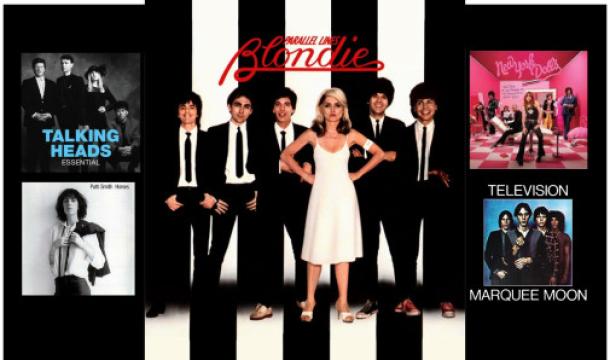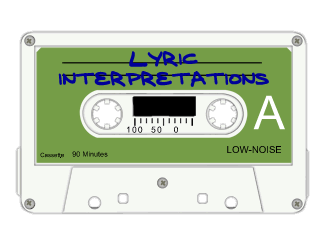Six Degrees of Blondie

Last time on Penguin Pete’s music history rabbit-hole, we examined the 1980s UK wave of New Wave music, starting from its Brit-punk roots, and connecting it all through Adam and the Ants. This time, we’re doing the same thing, but with the other half of the New Wave genre starting from its New York roots, centering on a unique little band we call Blondie.
Ah, Blondie! I don’t cop to misty-eyed nostalgia very often, but seeing Debbie Harry’s face and hearing her voice for the first time about the late-’70s, of course I swooned. We all did. Blondie came out of the end of the disco era, and promptly steered pop music in a bold new direction. New Wave had three main components – post-punk music styles, fusion with other pop genres, and romanticism. The UK brought the romanticism and their brand of punk to the table. New York brought the arty, experimental side to New Wave, and the fusion of the two produced the distinctive style that made many of these bands still popular today.
The Formation of Blondie
Once upon a time, there was “Wind in the Willows,” a band named after the British children’s book of the same name and also the source novel for the Disney animation that would lend itself to Disneyland’s most popular dark ride, Mr. Toad’s Wild Ride. Debbie Harry started out as a backup singer in Wind in the Willows, a folk band that produced one eponymous album and fizzled. The other band to know is the Magic Tramps, with Chris Stein on guitar. Chris Stein would go on to date Harry for a while before breaking off in the late 1980s.
Harry and Stein left their respective bands and formed Edna and the Stilettos, a band I can scarcely prove exists. But hey, there’s a song, hopefully correctly attributed because there was another New York punk band called “Stilettos” which I keep running into.
As you can hear from this song, this band was not the right fit for Harry. Edna and the Stilettos was trying to be Riot-GRRL crossed with a camp-retro edge that both Talking Heads and B-52s would carry out with far more success. But adhering to true punk style would waste Harry’s golden voice, so Harry and Stein teamed with Billy O’Conner on drums and bassist Fred Smith to form the first line-up of Blondie in 1974.
Fred Smith would stick it out in Blondie until the summer of 1975 and then…
Fred Smith Left Blondie For Television
Here’s where Blondie hooks into the New York post-punk / New Wave network. This microcosm centered on some legendary influences – Andy Warhol and the Velvet Underground, the infamous CBGB nightclub, and another nightclub called Max’s Kansas City. Pretty much all of our cast today orbited one or the other, sometimes all three.
But I mentioned Velvet Underground there, and yet they were already passing the torch to a new successor. New York Dolls came onto the scene in the early 1970s and briefly because the Big Apple’s mascot punk band.
Even though they sound surprisingly tame for having that honor. Despite how much of a cult following they have now, New York Dolls only hung in there for a couple albums and then hung it up in the late 1970s, only reforming by the 21st century. Meanwhile two New York Dolls members – drummer Jerry Nolan and lead guitar Johnny Thunders – teamed up with bassist Richard Hell from… Television! Yes, that’s where we were going with this. Those three formed the band Heartbreakers – no relation to Tom Petty’s band.
The Heartbreakers was almost a supergroup. Blondie’s drummer Clem Burke compared them to the punk rock Beatles, because each one stood out. And like all supergroups, it was unstable from so much talent clashing on one stage, so Richard Hell left for his own solo gig. Meanwhile, Television filled the slot in their line-up with bassist Fred Smith, who had been with Harry ever since the Stilettos!
So that’s New York Dolls and Television providing one link between Blondie and the rest of the new York punk scene. But we have much more to add to this rock ‘n’ roll family tree.
Guitarist Ivan Kral Left Blondie To Play With Patti Smith
You know we can’t get very far in New York punk culture without mentioning Patti Smith. In the mid-70s, Smith’s line-up absorbed the former Blondie guitarist. The most notable connection here, however, is that drummer Andy Paley left Elliot Murphy’s band soon after to also join Patti Smith’s act.
What’s so significant about the Elliot Murphy band? Well, when that band split up, keyboardist Jerry Harrison left to join… Talking Heads! So yes, after David Byrne had been kicking around the New York ‘70s scene with the bands Bazadi and The Artistics, Talking Heads began to form in 1974. We’re right back to the CBGB club again, where Talking Heads first took the stage opening for the Ramones – another staple of New York punk which ties into the whole thread about because drummer Marc Bell left Richard Hell (hay it rhymes!) for Ramones.
And That’s the Whole Story of New Wave
Between the UK and New York factions, we’ve managed to cover the most influential bands in the new wave scene, and quite a lot of its punk origins as well. Thanks as always for joining me on my rock history safaris!

 Buy the Soundtrack, Skip the Movie: Brainscan (1994)
Buy the Soundtrack, Skip the Movie: Brainscan (1994)  Let’s Go to the Hop - Ignore That Door’s Four Bunnie...
Let’s Go to the Hop - Ignore That Door’s Four Bunnie...  Forgotten Weird Music Videos of the Ancient 80s | vol 3
Forgotten Weird Music Videos of the Ancient 80s | vol 3  Forgotten Weird Music Videos of the Ancient 80s | vol 2
Forgotten Weird Music Videos of the Ancient 80s | vol 2  Forgotten Weird Music Videos of the Ancient 80s | vol 1
Forgotten Weird Music Videos of the Ancient 80s | vol 1  Let’s Chase Taylor Swift Rumors
Let’s Chase Taylor Swift Rumors  When the Beatles Touched Off a Movie War
When the Beatles Touched Off a Movie War  When Mike Bloomfield Composed a Soundtrack For Andy ...
When Mike Bloomfield Composed a Soundtrack For Andy ...  Yet Another List of Bad Song Covers
Yet Another List of Bad Song Covers  Why Does Everybody Pick On Liberace?
Why Does Everybody Pick On Liberace?  Trainspotting Soundtrack Revisited : One of the Best...
Trainspotting Soundtrack Revisited : One of the Best...  Nicki Minaj and Megan Thee Stallion: Bringing Back t...
Nicki Minaj and Megan Thee Stallion: Bringing Back t...  Quirky Songs About Los Angeles
Quirky Songs About Los Angeles  Penguin Pete’s Obligatory Penguin Cafe Orchestra Post
Penguin Pete’s Obligatory Penguin Cafe Orchestra Post  Heart | How Bad Are Those Animals?
Heart | How Bad Are Those Animals?  That Time Ronnie James Dio Saved Black Sabbath’s Bacon
That Time Ronnie James Dio Saved Black Sabbath’s Bacon  What is a Left Hand Path? - Entombed and Swedish Dea...
What is a Left Hand Path? - Entombed and Swedish Dea...  Song Analysis Corner: Convoy (1975)
Song Analysis Corner: Convoy (1975)  What’s Up With Margaritaville?
What’s Up With Margaritaville?  This Album Links Duran Duran, Andy Warhol, and Kurt ...
This Album Links Duran Duran, Andy Warhol, and Kurt ...  Your Back-To-School Playlist
Your Back-To-School Playlist  Cucumber Castle | the other Bee Gees Movie
Cucumber Castle | the other Bee Gees Movie  Danny Elfman Scores New Film; Other Movie Weirdness!
Danny Elfman Scores New Film; Other Movie Weirdness!  Sparks Is Not Crying in Their Latte
Sparks Is Not Crying in Their Latte  Travis Scott : Rapper, Cannabis Entrepreneur, Filmmaker
Travis Scott : Rapper, Cannabis Entrepreneur, Filmmaker  Anders Runestad – Author and Music Blogger
Anders Runestad – Author and Music Blogger  What If They Really ARE Giants?
What If They Really ARE Giants?  Prince’s Underrated Under the Cherry Moon
Prince’s Underrated Under the Cherry Moon  Six Degrees of Blondie
Six Degrees of Blondie  Six Degrees of: Adam and the Ants
Six Degrees of: Adam and the Ants  Discovering Beat-Club | Vintage West German Music Show
Discovering Beat-Club | Vintage West German Music Show  Eurovision Contest Winners part 2
Eurovision Contest Winners part 2  Song Analysis Corner: Snoopy vs. the Red Baron | The...
Song Analysis Corner: Snoopy vs. the Red Baron | The...  Eurovision Contest Winners part 1
Eurovision Contest Winners part 1  KISS SUXX!
KISS SUXX!  You Haven’t Met Your Last Reefer Man
You Haven’t Met Your Last Reefer Man  Ruth Underwood and the “Zappa sound”
Ruth Underwood and the “Zappa sound”  Catchy Commercial Earworms | vol 2
Catchy Commercial Earworms | vol 2  Song Analysis Corner: “Trouble Every Day” | Frank Zappa
Song Analysis Corner: “Trouble Every Day” | Frank Zappa  Blues Music For Your Great Recession
Blues Music For Your Great Recession  We Can Fix America If We Just Bring Back Schoolhouse...
We Can Fix America If We Just Bring Back Schoolhouse...  Song Analysis Corner: Istanbul (Not Constantinople)
Song Analysis Corner: Istanbul (Not Constantinople)  Music To Shoot Down UFOs To
Music To Shoot Down UFOs To  Are You Ready For AI Music?
Are You Ready For AI Music?  How Dreary Was 1970s Adult Contemporary?
How Dreary Was 1970s Adult Contemporary?  I Just Called To Say Stevie Wonder's Song Deserved a...
I Just Called To Say Stevie Wonder's Song Deserved a...  "Knock On Wood" | The Real Song To Remember From Cas...
"Knock On Wood" | The Real Song To Remember From Cas...  Dr. Dre's Not Gonna Take This Anymore
Dr. Dre's Not Gonna Take This Anymore  Apache - The Shadows | A Surf-Rock Safari
Apache - The Shadows | A Surf-Rock Safari  New Year : New Music Artists You (Probably) Haven't ...
New Year : New Music Artists You (Probably) Haven't ...  Song Odyssey | I Put A Spell on You
Song Odyssey | I Put A Spell on You  KMart and S.S. Kresge | Music Mystery?
KMart and S.S. Kresge | Music Mystery?  Did I Ever Introduce You To Horrorpunk?
Did I Ever Introduce You To Horrorpunk?  Song Analysis Corner : The Coffee Song
Song Analysis Corner : The Coffee Song  Duran Duran Finally Got Inducted
Duran Duran Finally Got Inducted  That Time Taylor Swift Broke Ticketmaster
That Time Taylor Swift Broke Ticketmaster  Parody Songs and Lawsuits | Of Interest To Aspiring ...
Parody Songs and Lawsuits | Of Interest To Aspiring ...  Worst Band Spats
Worst Band Spats  Rock and Roll Bookshelf | Corey Taylor's Seven Deadl...
Rock and Roll Bookshelf | Corey Taylor's Seven Deadl...  Lizzo, the Flute, and Racist-Sexist Republican Fallout
Lizzo, the Flute, and Racist-Sexist Republican Fallout 